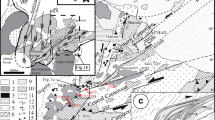Abstract
The rocks of the Delhi Supergroup, which occur around Barr-Sendra and Phulad-Deogarh regions in Central Rajasthan, show three phases of deformational episodes: (i) phase D1—tight-to-long limbed isoclinal fold (F1); phase D2—open, asymmetric fold (F 2) controlling the map pattern of the formational boundaries; and (iii) phase D3—major warps (F3). Interference between nearly coaxial F1 and F2 on northerly axes produced hook-shaped and crescent patterns whereas superimposition of easterly trending F3 on F2 produced dome-and-basin patterns. The thermal peak was achieved during the second phase of deformation when the rocks were constructively metamorphozed and granites (850−750 m.y.), late synkinematic with respect to second phase of deformation, were emplaced. The sequence of deformation and the structural pattern of the rocks of the Delhi Supergroup in Central Rajasthan strikingly resemble those in northeastern Rajasthan. Structurally the characteristics of the Delhi Supergroup as verified in the entire region from NE to Central Rajasthan are: (a) the same sequence of development of folds, F1, F2 and F3, interspersed with nearly identical phases of recrystallization, (b) hook-shaped interference pattern due to near-coaxial refolding of F1 by F2, and (c) variation in axial plunge of F2 resulting in culminations and depressions. Lastly, phases of the recrystallization history indicates little time gap between F1 and F2, and a considerable gap between F2 and F3.
Similar content being viewed by others
References
Biswal T K 1988 Polyphase deformation in Delhi rocks southwest of Amirgad, Bansakuntha Disc, Gujarat.In: Precambrian of the Aravalli Mountain, Rajasthan, India (ed.) A B Roy (Geol. Soc. India Mem. 7 267–278)
Gangopadhyay P K 1972 Structure and tectonics of Alwar region in north-eastern Rajasthan, India, with special reference to Precambrian stratigraphy;Twenty fourth Int. Geol. Congr. 1 118–125
Gangopadhyay P K, Gangopadhyay A and Lahiri A 1984 Some aspects of the tectonic evolution of the Delhi Supergroup of rocks in Central Rajasthan;Indian J. Earth Sci., Monogr. Vol. pp. 134–160
Gangopadhyay P K and Lahiri A 1983 Barr Conglomerate: its recognition and significance in relation to the stratigraphy of the Delhi Supergroup;J. Geol. Soc. India 24 562–570
Gangopadhyay P K and Lahiri A 1984 Earth’s crust and evolution of the Delhi Supergroup in Central Rajasthan;Indian J. Earth. Sci. CEISM Seminar Volume 92–113
Gangopadhyay P K and Lahiri A 1986 Some problems on geochronology of the Precambrian rocks of Rajasthan: an appraisal;Indian J. Earth Sci. 13 169–188
Gangopadhyay A and Mukhopadhyay D 1987 Structural Geometry of the Delhi Supergroup Near Sendra—an example of the impress of granite diapirism on tectonic structures; In:Geological evolution of Peninsular India, Recent research in geology (ed.) A K Saha (Delhi: Hindustan Publishing Company) Vol. 13, pp. 45–60
Gangopadhyay P K and Sen R 1975 Structural framework in Delhi Group of rocks with special reference to interference patterns; a study around Kushalgarh, north-eastern Rajasthan;J. Geol. Soc. India 16 317–325
Huddleston P J 1973 Fold morphology and some geometrical implications of theories of fold development;Tectonophysics 16 1–46
Heron A M 1953 The geology of Central Rajasthan;Mem. Geol. Surv. India 79 pp. 1–389
Naha K, Mukhopadhyay D K, Mohanty R, Mitra S K and Biswal T K 1984 Significance of contrast in the early stages of the structural history of the Delhi and the pre-Delhi rock groups in the Proterozoic of Rajasthan, Western India;Tectonophysics 105 193–206
Naha K, Mukhopadhyay D K and Mohanty R 1988 Structural evolution of the rocks of the Delhi Group around Khetri, north-eastern Rajasthan; In:Precambrian of the Aravalli Mountain, Rajasthan, India (ed.) A B Roy, (Geol. Soc. India Mem. 7 207–246)
Ramsay J G 1967Folding and fracturing of rocks, (New York: McGraw Hill) pp. 1–568
Ramsay J G and Huber M I 1987The techniques of modem structural geology Folds and fractures. (London: Academic Press) Vol. 2 pp. 1–700
Roy A B and Das A R 1985 A study of time relations between movements, metamorphism and granite emplacement in the Middle Proterozoic Delhi Supergroup of Rajasthan;J. Geol. Soc. India 26 726–733
Sen S 1971 Precambrian structural history around Rajgarh, Rajasthan;Q. J. Geol. Min. Met. Soc. India 43 182–211
Sengupta S 1988 Development of successive sets of structures in a process of continuous deformation: a case study from the Delhi metasediments near Kharwa, Ajrner Dist., Rajasthan, India;J. Earth. Sci. 15 116–131
Sharma R S 1988 Patterns of metamorphism in the Precambrian rocks of the Aravalli Mountain Belt; In:Precambrian of the Aravalli Mountain, Rajasthan, India. (ed.) A B Roy (Geol. Soc. India Mem. 7 33–75.)
Sychanthavong S P and Desai S D 1977 Proto-plate tectonics controlling the pre-cambrian deformations and mettalogenetic epochs of North-Western Peninsular India;Miner. Sci. Eng. 9 218–236
Author information
Authors and Affiliations
Rights and permissions
About this article
Cite this article
Gangopadhyay, P.K., Lahiri, A. Structural characteristics of the rocks of the Delhi Supergroup with special reference to interference patterns: An appraisal with some examples from Central Rajasthan. Proc. Indian Acad. Sci. (Earth Planet Sci.) 99, 309–320 (1990). https://doi.org/10.1007/BF02839397
Issue Date:
DOI: https://doi.org/10.1007/BF02839397




